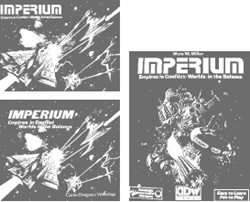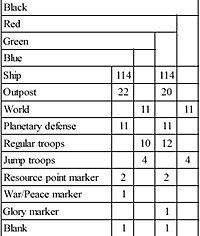
Conflict Games (1977, $11.98 - mounted map)
GDW (1977, $9.98 - paper map)
GDW (1992, $24.00 - puzzle map)
Designed by Marc W. Miller, Frank Chadwick, John Harshman
Players 2
Playing Time 2-3 hours
Period Science Fiction
Scale Strategic
Turn 2 years
Map one-half parsec
Unit one capital ship or reinforced division
Components
[Conflict Games mounted map edition]
Container 10 1/2" x13 1/2" x2 1/2" bookcase style box
1 19 1/2" x 25 1/2" mounted mapboard
352 die-cut 3/4 1/2" counters
1 12 page rulebook
2 identical cards of game charts
1 six-sided die 6
cardboard counter trays (4 1/2" x 4 7/8" x 1 1/2")
1GDW product list
 Counter Manifest (all editions)
Counter Manifest (all editions)
[GDW paper map edition]
Container 11x14" flatbox
1 20 1/2" x 25 1/2" unmounted mapsheet
352 die-cut 3/4 " counters
1 12 page rulebook (Conflict Game Company)
2 identical cards of game charts
1 six-sided die
[GDW 1992 puzzle map edition]
Container 9" x 11 " thin bookcase box
1 17"x22" mapboard (consisting of 4 puzzle mapboard sections on thick cardboard)
352 die-cut 3/4" counters
1 16 page rulebook
1 8 page background history book
1 4 page folder of charts and tables
1 record card
1 six-sided die
GDW says:
“Imperium pits an expanding Terran Confederation against a vast interstellar empire in a series of wars of colonial expansion. Two players work against each other, each striving to win through strategic sense and tactical skill. The action includes space combat, planetary invasions, and economic production as both players fight a series of wars for supremacy.”
The reviewers say:
“Imperium is intended to be a campaign game consisting of a series of wars fought until one side controls the entire board. Each war is a single game, which could be played independently. At the end of each game, a die is rolled to determine the length of the peace before the next war begins, repatriation of forces, territorial exchanges, interwar income, postwar production, interwar attrition, interwar production, interwar colonization and redistribution of forces.” Don Lowry in Campaign 84.
“A nice feature of the counter mix is the very wide variety of unit types for both the Terran and the Imperial player, ranging from Scouts, Destroyers, Missile Boats and four types of Cruisers ... to Dreadnoughts and Battleships, and including auxiliaries such as Transports and Tankers ... Where chrome exists it is put to good effect and is in subtle harmony with the mechanics of the game ... The overall result is a clean, fast moving, but very convincing game.” Hugh Baldwin in The Wargamer 11.
“Imperium has a strong economic base, determined by planetary holdings and, for the Imperial player, a budget. Troops, planetary defenses, outposts, and ships must all be paid for. In addition, ships must be maintained if a player wishes to retain his fleet in fighting trim ... Imperium brings together many common themes of science fiction, and ties them to an excellent and intriguing game system ... Its ease of play makes it an enjoyable game. I predict it will be a classic.” Tony Watson in Space Gamer 15.
“This is either a serendipitous design or a cold-blooded development of a classic. Nicely conceived and beautifully executed.” David Ritchie in Ares 1.
Comments
As predicted, Imperium did become a wargaming classic -- and it has just been reborn in a revised edition published by Avalanche Press.
Collector’s Notes
For the Conflict Games edition, Boone lists low/high/average prices of 10/24/ 15.14 at auction and 5/60/18.83 for sale. Caveat emptor -- those Conflict Games mounted mapboards tend to warp badly! This is not a factor of age as the contemporary reviews note the problem.
Boone lists GDW’s Imperium at 5/30/ 15.18 at auction and 9/30/14.23 for sale without distinguishing between 1977 and 1992 editions.
Article References
Additional Units for Imperium, Space Gamer 17;
Imperium & Warp War (combining the games), Space Gamer 19;
Modified Rules for Imperium, Space Gamer 17;
Strategies for Imperium, Campaign 94;
Tactics in Imperium, Grenadier 2.
Other games by this designer
1942; Agincourt; Asteroid; Belter; Chaco; Dark Nebula; Double Star; Fifth Frontier War; Invasion Earth; Mayday; Raphia; Snapshot; Team Yankee; Traveller RPG; Triplanetary (all GDW).
The Remulak controversy
“Imperium has good points and bad, the good ahead by a slim margin. I think it’s worth your time since it shows a real regard for science fiction among the designers. The Steve Fabian box art is nice, too. If only you hadn’t named that one star system ‘Remulak.’” Dave Minch in The Dragon 18.
“Some stars have been given names. Most of these are believable, the only exception being the one called ‘Remulak’ (not funny or likely).” Dave Minch in F&M 13.
“The GDW staff couldn’t refuse a few jokes, of course ... the planet Remulak has mysteriously appeared (in response to Akroid (sic) and Belushi class destroyers in Battleline’s Alpha-Omega, I’m told).” Phil Kosnett in Moves 37.
Remulak was the home planet for Saturday Night Live’s alien family “The Coneheads”.
Capsule Profiles:
Back to Simulacrum Vol. 4 No. 1 Table of Contents
Back to Simulacrum List of Issues
Back to MagWeb Master Magazine List
© Copyright 2001 by Steambubble Graphics
This article appears in MagWeb (Magazine Web) on the Internet World Wide Web. Other articles from military history and related magazines are available at http://www.magweb.com